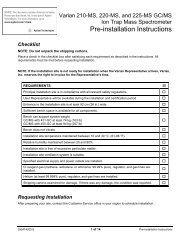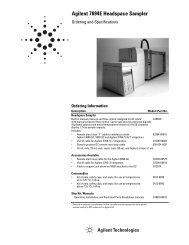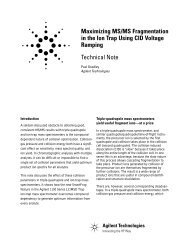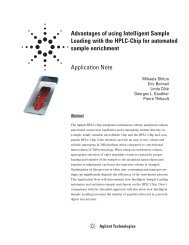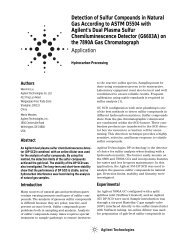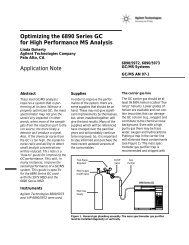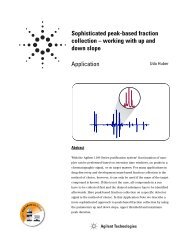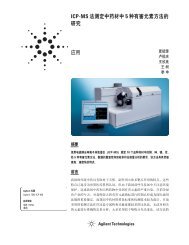Specific Determination of Bromate and Iodate in Ozonized Water by ...
Specific Determination of Bromate and Iodate in Ozonized Water by ...
Specific Determination of Bromate and Iodate in Ozonized Water by ...
Create successful ePaper yourself
Turn your PDF publications into a flip-book with our unique Google optimized e-Paper software.
Introduction<br />
<strong>Bromate</strong> can be formed <strong>by</strong> the<br />
oxidation <strong>of</strong> bromide ions dur<strong>in</strong>g<br />
ozonation <strong>and</strong> possibly <strong>by</strong> other<br />
oxidants <strong>in</strong> water treatment [1-4].<br />
<strong>Bromate</strong> has been estimated as a<br />
potential carc<strong>in</strong>ogen, <strong>and</strong> has<br />
been classified <strong>in</strong> Group 2B <strong>by</strong><br />
the International Agency <strong>of</strong><br />
Research on Cancer (IARC).<br />
The concentration <strong>of</strong> bromate <strong>in</strong><br />
dr<strong>in</strong>k<strong>in</strong>g water associated with an<br />
excess lifetime cancer risk <strong>of</strong> 10 -5<br />
corresponds to 3 µg/L [5]. The<br />
World Health Organization (WHO)<br />
recommended the provisional<br />
guidel<strong>in</strong>e value <strong>of</strong> 25 µg/L which is<br />
associated with an excess lifetime<br />
cancer risk <strong>of</strong> 7 x 10 -5 , because <strong>of</strong><br />
limitation <strong>in</strong> available analytical<br />
<strong>and</strong> treatment methods [5].<br />
Ion chromatography (IC) with a<br />
pretreatment method [6] or an<br />
on-l<strong>in</strong>e preconcentration method<br />
[7-8] has been reported for the<br />
determ<strong>in</strong>ation <strong>of</strong> trace bromate.<br />
However, the peak <strong>of</strong> bromate at<br />
the detection limit level will <strong>of</strong>ten<br />
vanish <strong>in</strong> that <strong>of</strong> chloride which is<br />
always present <strong>in</strong> water at a level<br />
<strong>of</strong> three orders <strong>of</strong> magnitude higher.<br />
The authors have developed a<br />
sensitive <strong>and</strong> selective ion<br />
chromatographic determ<strong>in</strong>ation<br />
method <strong>of</strong> bromate with<br />
postcolumn conversion <strong>in</strong>to<br />
tribromide <strong>by</strong> hydrobromic<br />
acid [9]. Sub-µg/L <strong>of</strong> bromate <strong>in</strong><br />
water was determ<strong>in</strong>ed <strong>by</strong> us<strong>in</strong>g<br />
the developed postcolumn<br />
derivatization. Furthermore, other<br />
dis<strong>in</strong>fectant <strong>by</strong>-products such as<br />
chlorite <strong>and</strong> iodate were also<br />
detected with similar detection<br />
limits.<br />
On the other h<strong>and</strong>, <strong>in</strong>ductively<br />
coupled plasma mass spectrometry<br />
(ICP/MS) comb<strong>in</strong>ed with liquid<br />
chromatography or IC (LC-ICP/MS<br />
or IC-ICP/MS) is an effective<br />
technique for the speciation study<br />
<strong>of</strong> metallic <strong>and</strong> organometallic<br />
species because <strong>of</strong> its element<br />
selectivity <strong>and</strong> sensitivity. The<br />
comb<strong>in</strong>ed technique has been also<br />
applied to the determ<strong>in</strong>ation <strong>of</strong><br />
halogen species, especially, iod<strong>in</strong>e<br />
that can be sensitively detected <strong>by</strong><br />
ICP/MS [10-14].<br />
In the present work, the specific<br />
determ<strong>in</strong>ation <strong>of</strong> bromate, iodate<br />
<strong>and</strong> other halogen species <strong>in</strong><br />
dr<strong>in</strong>k<strong>in</strong>g water <strong>by</strong> direct <strong>in</strong>jection<br />
us<strong>in</strong>g IC with ICP/MS <strong>and</strong> the<br />
postcolumn derivatization is<br />
described. The advantages <strong>of</strong><br />
ICP/MS as an element selective<br />
detector was evaluated for bromate<br />
<strong>and</strong> iodate <strong>by</strong> consider<strong>in</strong>g the<br />
comparison with the postcolumn<br />
derivatization. Furthermore, the<br />
IC-ICP/MS system was applied to<br />
the simultaneous determ<strong>in</strong>ation<br />
<strong>of</strong> halogen anions <strong>in</strong> raw <strong>and</strong><br />
ozonized water.<br />
Experimental<br />
Reagents<br />
All reagents used were purchased<br />
from Wako Pure Chemical<br />
Industries (Osaka, Japan). Stock<br />
solutions (1000 mg/L as elements)<br />
for each anion were prepared <strong>by</strong><br />
dissolv<strong>in</strong>g with pure water <strong>and</strong><br />
stored <strong>in</strong> refrigerator. Analytical<br />
solutions were prepared <strong>by</strong><br />
dilut<strong>in</strong>g the stock solution to<br />
the required concentration just<br />
before use. Pure water was<br />
obta<strong>in</strong>ed from Milli-Q system<br />
(Nihon Millipore, Tokyo, Japan).<br />
Instrument<br />
Ion chromatograph used <strong>in</strong> this<br />
experiment was Model IC7000S<br />
(Yokogawa Analytical Systems<br />
Inc., Japan) equipped with a<br />
UV/VIS detector, <strong>and</strong> ICP/MS was<br />
Model 4500 (Agilent Technologies,<br />
Inc. USA). Excelpak ICS-A23 <strong>and</strong><br />
ICS-A13 (7.6 mm x 4.6 mm i.d.<br />
each, Yokogawa Analytical<br />
Systems Inc.) were chosen as<br />
separation columns. ICS-A23<br />
<strong>and</strong> ICS-A13 were packed with<br />
hydrophilic <strong>and</strong> semi-hydrophilic<br />
anion exchange res<strong>in</strong> with<br />
0.05 mequiv./g <strong>of</strong> dry, respectively.<br />
IC-ICP/MS<br />
Ion chromatograph <strong>and</strong><br />
ICP/MS were connected <strong>by</strong><br />
500 mm x 0.3 mm i.d. <strong>of</strong> ETFE<br />
tube. Ammonium carbonate was<br />
chosen as a mobile phase.<br />
Ammonium salt was used to<br />
prevent a salt deposition <strong>and</strong><br />
clogg<strong>in</strong>g at sampl<strong>in</strong>g orifice <strong>of</strong><br />
ICP/MS caused <strong>by</strong> sodium <strong>in</strong> a<br />
mobile phase. The operat<strong>in</strong>g<br />
conditions <strong>of</strong> ICP/MS are<br />
described <strong>in</strong> Table 1.<br />
Postcolumn derivatization<br />
Two Excelpak ICS-A13 columns <strong>in</strong><br />
series were chosen to separate the<br />
halogen species accord<strong>in</strong>g to the<br />
previous paper [9]. The operat<strong>in</strong>g<br />
conditions <strong>of</strong> the postcolumn<br />
derivatization are described <strong>in</strong><br />
Table 2.<br />
Results <strong>and</strong> Discussion<br />
Separation <strong>of</strong> halogen anion<br />
First <strong>of</strong> all, the separation <strong>of</strong><br />
halogen anions us<strong>in</strong>g ICS-A13 as<br />
the separation column accord<strong>in</strong>g<br />
to previous paper [9] was<br />
exam<strong>in</strong>ed to establish appropriate<br />
separation conditions. The<br />
chromatography behaviour <strong>of</strong><br />
iodide on anion-exchange res<strong>in</strong>s<br />
has been described [15]. In this<br />
experiment, however, the peak <strong>of</strong><br />
iodide showed a broad <strong>and</strong> tail<strong>in</strong>g<br />
shape, while bromate, bromide<br />
<strong>and</strong> iodate showed good peak<br />
shapes. It was also noted that the<br />
retention time was long (more<br />
than 30 m<strong>in</strong>) <strong>and</strong> depended on its<br />
concentration. It was not drastically<br />
improved <strong>in</strong> spite <strong>of</strong> a series<br />
<strong>of</strong> change <strong>of</strong> mobile phase.<br />
2



